Soweto’s Vibrant Heritage and Lifestyle
Preliminary remark: In February 2024, a German EVC team took part in a workshop in South Africa (-> Link). On 18 February 2024, Katharina Fink organised a guided hike through Meadowlands for this group. The guide was Masike Lebele, who grew up here. In the following contribution, Masike uses selected photos (taken in 2024 but also on another tour in June 2025) to explain his concept for these hikes, which he offers to interested parties.
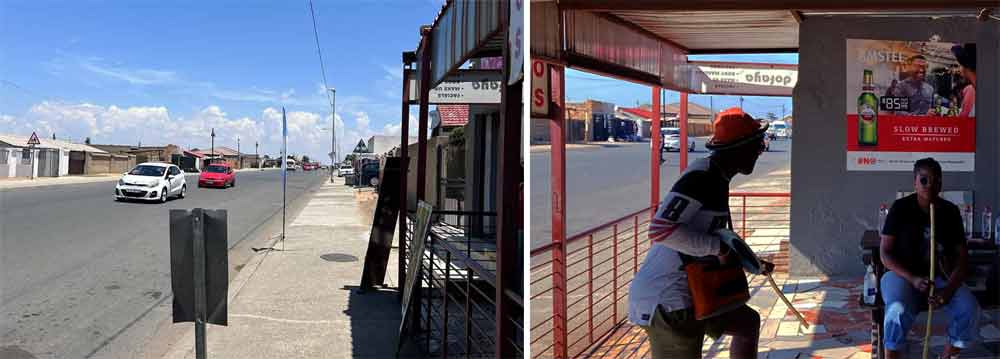
Meadowlands, Modubane Street (Photo Christiane Schmidt-Maiwald)
That picture shows the main road of Zone 1 Meadowlands.[1] Here we start. This was my grandparents’ place that we turned into a small tavern and restaurant. It is situated at the corner of that main road. A very busy corner. So it was good to open a business there. We start and end all our hikes here. People can have their coffee and drinks and they can have refreshments and food when we come back from hiking. And use the toilets and safe parking. That’s where everything starts.

Masike Lebele (Photo Ernst Wagner)
My name is Masike Lebele, born in Soweto. I am 42 years old. After my study of travel and tourism in Johannesburg, I worked for various travel agencies. I actually got my experience from Legacy Group, creating travel products for them, to design the ultimate travel experience. That is actually where I took the idea to create a product here in Soweto that is going to be new and also something to refresh tourism in Soweto. A new activity and a new way to see Soweto, other than going to the ordinary places. It was a chance to put communities together, especially after all the apartheid we went through. To create a new atmosphere, because in the end of day we are living here together. I created this five to six kilometers hike. It is a spiritual and formative motivation and educational hike on the periphery of Soweto.
Zone 1 is where my grandma and grandpa were moved to during the apartheid removals from Sofiatown and Alexander. My mother was the 1st born of their 7 kids and I was the 1st grandson in the family. My father was absent most of my life so I took my strict grandpa as my father figure. I grew up next to him learning a lot of skills from him, both life and business. I actually started driving a car when I was 10 years old and trucks from 13 years old.

Rand Leases / Fleurhof - near Helpmekaar Road (Photo Christiane Schmidt-Maiwald)
The area you see here is just 500 meters from the start. That area is considered the Holy Land. Where the people are standing in the white and blue garments, there is a church ritual that is going on there. They are performing a ritual of baptizing, next to a flowing stream. Other rituals are performed at a dam nearby, others by the passing street. These rituals have been going on since forever, because of the running water. That is through African spirituality.

Colored wax from candles on the ground (Photo Ernst Wagner)
On our way, in certain places, especially near springs, you can also see colored candles. These candles are used to conduct specific rituals, to pray. (2) They come in different colors. Each color candle represents a specific notion. For instance the white ones are generally used for clarity and transparency or pureness. Also the other colors represent a certain notion. There is even a black candle. When you are initiated as a Sangoma you are trained and you are taught what each of the colored candles stands for.
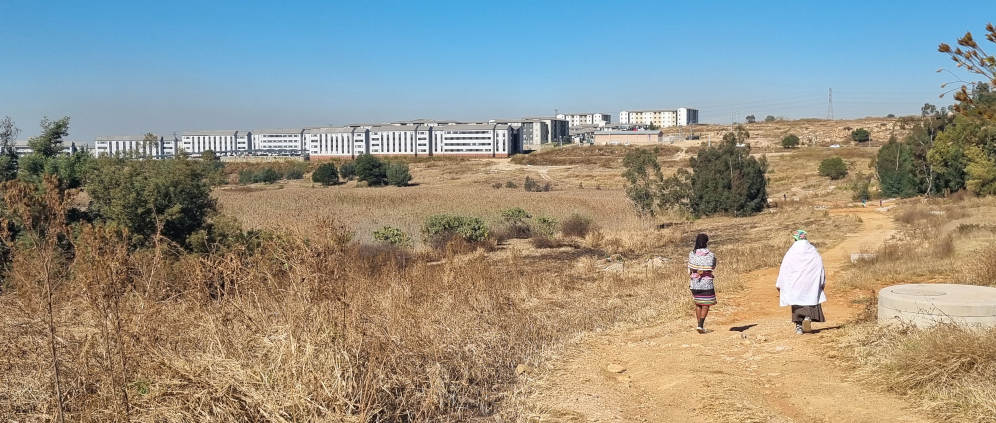
The newly constructed buildings (Photo Ernst Wagner)
The buildings that we see behind are new flats. Housing development programs are happening here for the community, for the people. The government is trying to source out new ways to accommodate people who haven’t received houses. So it is a new type of housing development, for rent, for buy – others are just given out by the government. This used to be our playground before that - when I was a young boy. We used to hunt rabbits or birds together with our dogs.

Rand Leases Gold Mine - near Helpmekaar Road (Photo Ernst Wagner)
In the background of this picture there is a green and yellow mine dump. The yellow sand is the residual that comes when they mine the gold. That is all the soil that comes from underground before they get to the gold. That’s why that has the yellow color. The soil is toxic. When it gets like dusty it blows into the community. That’s why it is covered with grass. This was an environmental project. The municipality and the mine planned to plant grass over the mine dumps.
I recently heard that there is a plan the Chinese proposed to refine these dumps because there is still a way that they can get gold out of this particular sand. That is an interesting thing. We have to see what happens about that.

Burning tires (Photo Ernst Wagner)
We have now crossed the road to climb up to the dump. This is the place where the smoke in the previous picture came from. It is already on the dump, but still at the bottom. There are guys who recycle the wires you find inside rubber tyres. They collect the car tyres and burn them, take the residual wires to the recycling centre to get some cash. You can see the wire in the ash.
I don’t think, it is illegal, as it is a way of recycling. It’s just that it damages the environment with felt fires and smoke pollution. It’s not much money they get. So the nyaope addicts are the ones who usually do it as it is a quite dirty job. Having to separate the wires from the burnt black ash. They get about 5 Rand (0,25 Euro) per tyre, not much, but it pays the bills for the addicts. (Nyaope or whoonga is an illegal local drug based on black tar heroine. It is widespread in South African townships since 2010.)

The Golden Mile (Photo Ernst Wagner)
After just four kilometers we arrive at my most favorite part on this hike. I call it the golden mile. The golden mile was created through erosion over the years. Water floats through the mine dump creating a kind of canyon. The water digs deep and creates this beautiful canyon. Because the erosion has been going on for years, it becomes so deep that you can walk within it. It is peaceful and cool. You are above the ground and within at the same time.
It also has beautiful and colorful birds. Sparrows which have a unique way of building their nests in holes in the canyon walls, also white owls with brown wings. These birds I found recently. This is the place where tourists take a lot of pictures because of the views. By the way, this particular space encouraged me to invite people to such hikes. (We have been nominated for the past three years for different awards in the tourism industry, and I am honored to have such a wonderful feedback.)
At the canyons, we also have international fashion photographers, e.g. from Germany, that use the canyon for photo shoots. They display the models with their haute couture dresses. They are very expensive dresses. They use the canyon for brilliant shots. Also local fashion models come to take pics for their content.
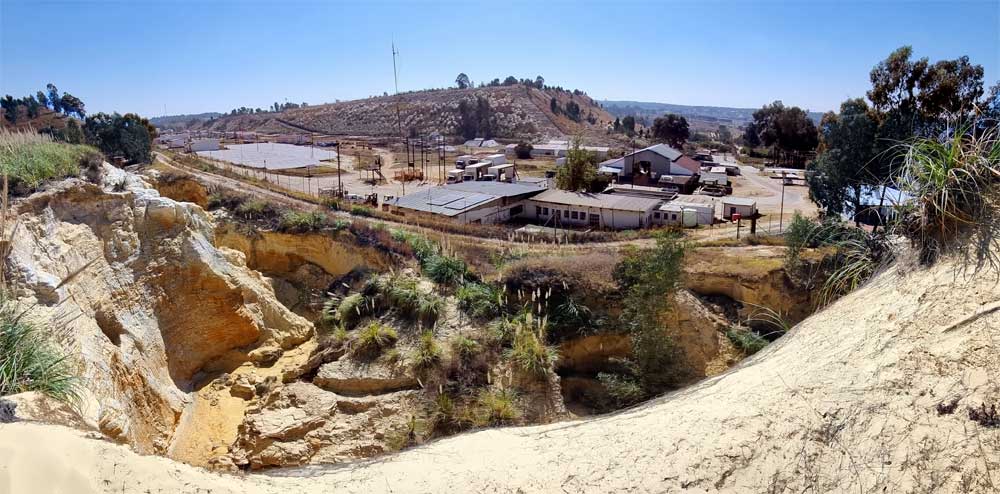
View from above the canyon (Photo Ernst Wagner)
As we leave the canyon and continue upward, we see these houses. There are two plants situated here. One is MAXAM, a Spanish explosives company. They make explosives there. They have a testing booth there to test the explosives. That’s all the noise of the explosions we hear when we are going up the dump. We hear that blasts that go off once in a while. They supply a lot of mines all over the world with those explosives. So, because my people lack knowledge of a lot of things, they always think it is mining that is happening there. But there isn’t any mining happening there. But, these explosions damage our homes. They are terrible. Imagine. It is like living in a warzone with all these blasts every day going off. People just got used to them.
The next plant is an Australian one, the West Wits Gold Mining Company. There is no more illegal mining since they established it in 2019. I hope that this mining company invests in my community and opens up opportunities for people in my community. They should help them create an economy of their own by teaching them skills that they can pass to the younger generation.

Resting place (Photo Ernst Wagner)
This place is halfway through the hike. It is our refreshment post. We call it France, because the first group that we hosted here was a French group. So, what happens here is that we get water and snacks - or lollipops for kids. But then we conclude everything that we have experienced on the hike. I am asking the participants what they have seen so far, on their perspectives, how they feel.
We just discuss and then I do a secrete, private prophecy for everyone – because, when we start, I ask them to pick up a pebble or a stone that connects with them. Each person keeps the stone with them until my announcement. That further notice is when we get to this place. Here we put all the stones together in a pile. Then I explain the uniqueness of our individual lives. We all have dreams, aspirations and different visions. We have things we want to accomplish.
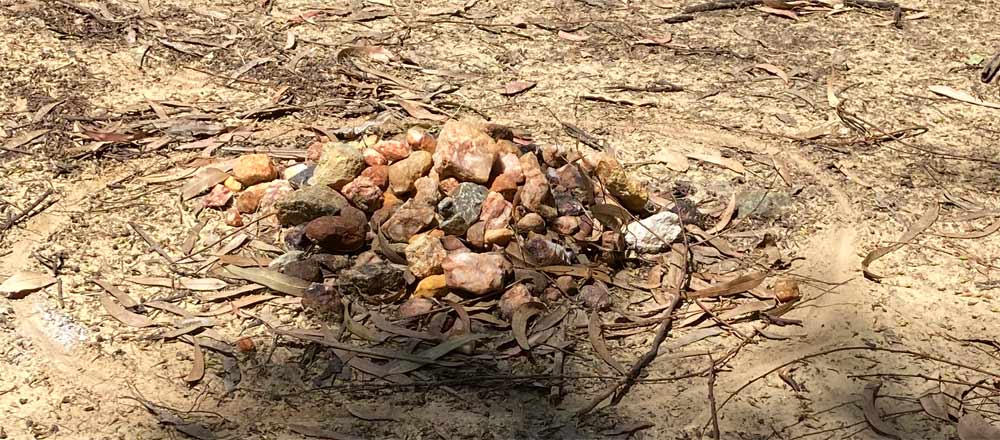
The collected stones (Photo Christiane Schmidt-Maiwald)
I am just trying to point out that we are all different and unique in life. There is no one who could ever do all the things one have thought of. So with the 'stone prophecy' I am just trying to show them that there is no other stone that can be the same as yours. I also explain some other stone and life prophecies in depth. It is very interesting. I don’t know how I got to do it, but it always opens up a lot of people’s minds. After that we go up the mine dump.

Rand Leases Gold Mine (Photo Nicole Berner)
When we climb up the sandy slope to the top of the dump, the view of Soweto suddenly opens up.

View from the top of the dump (Photo Nicole Berner)
I don’t know even where to start to tell my experience about Soweto. Soweto is home. Soweto is the only place I know (laughing). It’s the place I spent most of my life. My parents, in the apartheid time, their families moved from Alexandra (3) to Soweto, because the government wanted to clean up that site of Johannesburg. My dad, my paternal side is from Diepkloof (4) and my maternal side is from Meadowlands. Even in Diepkloof our backyard is also a mine dump. So, I have been growing up within these golden dunes.
My parents bought a home in a suburb in Soweto, but unfortunately they had a divorce. But I was pretty young. So during the divorce happened I had to go to stay with my grandmother in Meadowlands. My sisters stayed with my mother.

Soccer (Photo Masike Lebele)
Growing up in Soweto I played soccer, right? Soccer is the number one sport here. I played for a lot of teams, junior level, and I ended up playing for the biggest team, Kaizer Chiefs. I played for them under 17 or 19. But at that stage I was doing my matric – my mom was very strict on me about my education. So I had to stop with the soccer and concentrate on the books. Yeah, now I studied. I did well for myself. I passed my matric. Something that's a very high oculate to have in the township. If you have that matric certificate, you're you are one foot in. It's a certificate that opens doors for you, in everything, every way that you can imagine, employment wise. So with the matric, you have advantage of getting a better job. So, in the township, having a matric is a big, big, big issue.
We grew up enjoying ourselves. Our teenage era was – wow – it was hectic, it was energetic, clubbing, you know, socializing, Monday to Monday, just having fun and not thinking about the other things in life, that you might grow up and become adult and have boring responsibilities, you see?

Soweto (Photo: Creative Commons Link)
Soweto, the place where I was born, the place where I had my family. I ran a couple of businesses that I used to work on part time with my grandfather. He played a very vital role in nurturing me as a guy because my dad was not available for me, you see. It's just these disadvantages when your parents separate. And now you must go all around: Going to your father's place, your cousin's place, your mother's place and so on. You know, everything is just a mix up. Most of the families here in Soweto our single headed families.
We don't have that family orientated marriage culture anymore. Everybody's just doing their own thing. Co-parenting, you see. Oh, it's not nice. I just feel we lost that Ubuntu family culture that Soweto used to have. Most of our grandfathers were married to our grandmothers. They came as couples, as big families, big and nice families. That's how everything happened. But through times all of these changes, yeah, they actually killed the social. Poverty actually killed that family orientated spirit. You don't have it anymore.
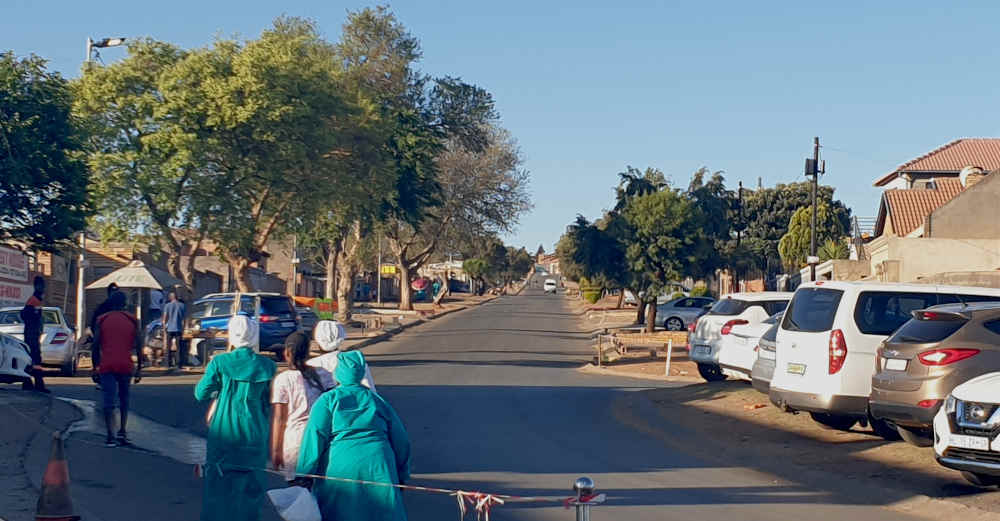
Situation in Soweto 2023 (Photo Ernst Wagner)
There are so many more problems here in Soweto. But because it is my hometown, I have that positive outlook that I can help to change the culture of it, that we can really make it a better place to stay in. You see, you don't choose your family, you are born into it. It's up to you to change your family. So I'm giving back to Soweto in every way I can. I'm helping, I'm educating the kids, I'm advising the youth. I'm chatting with a lot of people that are concerned about our well-being.
That's Soweto, a place I call home. A place with loving people. They were just placed there, you know, they didn't plan to live there. They were brutally placed by that system that needed them into anguish and poverty.
But we are all God's people, if I can put it that way, and God wants everything good for us as he is good. So we love each other in Soweto. It's a friendly place, friendly people. It's a nice place to be, a nice place to experience. Soweto is rich of history, full of heroes and people who changed and put a mark in the world.
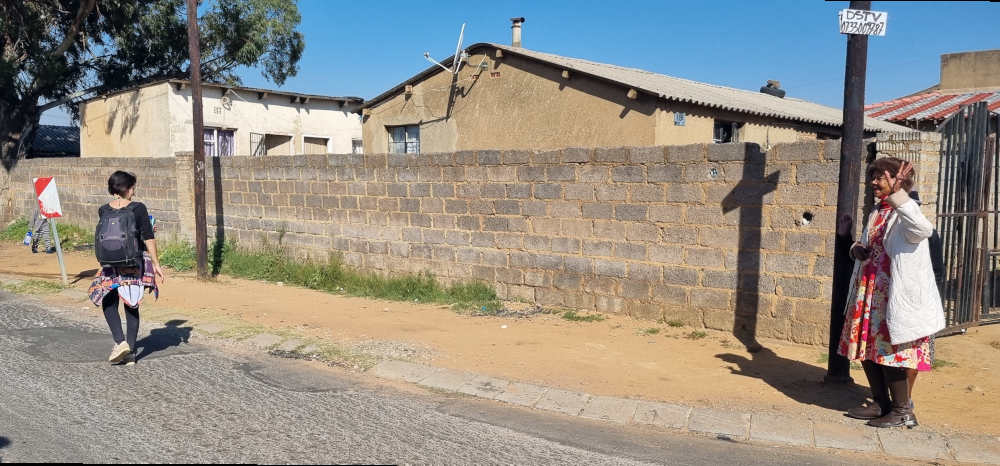
Situation in Soweto 2025 (Photo Ernst Wagner)
Footnotes
[1] Meadowlands is a neighbourhood in Soweto (Johannesburg, South Africa). The district was founded in 1955 in accordance with the Group Areas Act of 1950 and the Natives Resettlement Act of 1954 as a settlement for black people, in particular for forcibly resettled residents of the Sophiatown neighbourhood of Johannesburg. The residents were divided into ethnic groups within Meadowlands. The houses were built using the most cost-effective methods possible. (https://en.wikipedia.org/wiki/Meadowlands,_Gauteng). See as well: https://en.wikipedia.org/wiki/Meadowlands_(song)
(2) These candles are used by traditional health practitioners, sangomas (Zulu term).Traditional healers are consulted by approximately 60% to 84% of the South African population, usually in conjunction with modern bio-medical services. https://de.wikipedia.org/wiki/Sangoma ; https://en.wikipedia.org/wiki/Traditional_healers_of_Southern_Africa
(3) During apartheid, Alexandra was one of the few neighbourhoods in Johannesburg that was inhabited by black people. In 1948, the government wanted to resettle the black population in Alexandra. Around 50,000 residents were forced to move to Tembisa and Soweto.
(4) The Diepkloof neighbourhood was founded in 1959 as a settlement for black people, in particular for forcibly relocated residents of the Alexandra township settlement.
-----------------------------------------------------------------------------------------------
Further reading
- Left Behind - Land after Mineral Extraction by Esther Kibuka-Sebitosi (Link)
- Two Cities -Two Economies by Esther Kibuka-Sebitosi (Link)
-----------------------------------------------------------------------------------------------
